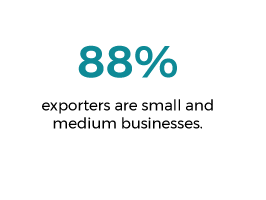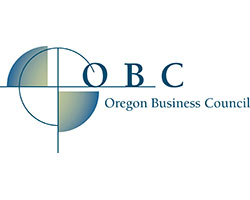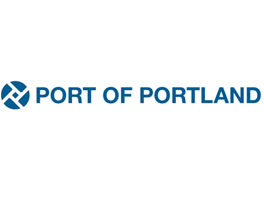Oregon’s State of Trade
This report, produced by the Portland Business Alliance, Pacific Northwest International Trade Association (PNITA) and the Value of Jobs coalition, with research conducted by ECONorthwest, tracks the latest data available on Oregon’s role in the global market.
Download Executive Summary (pdf)
When it comes to international trade, Oregon continues to punch above its weight. From Tillamook cheese, to Columbia Sportswear and A-dec medical equipment, we produced and exported a record $28 billion in goods and services in 2017. Jobs connected to trade pay more, and are three times more productive, contributing to the health and resiliency of our economy.
Oregon’s location along the Pacific Rim offers efficient transport of goods via air, water, rail and road to national and international markets. At the same time, a growing list of direct air connections is helping connect Oregon businesses to the world and tourists to our state.
While this report looks at the latest production and export statistics available, news of volatile policy negotiations and a global cooldown on trade are beginning to show their impact. An increase in policy barriers ultimately means less trade activity, leaving Oregon’s economy vulnerable to job and wage impacts.
Trade in Oregon at a Glance





One-fifth of jobs in Oregon are supported by trade, and are reflected in a variety of industries, including advanced manufacturing, high-tech, agriculture, sports apparel, business services, tourism, and forest and wood products.
A total of 505,700 direct and indirect jobs across Oregon are supported by international trade and expand across rural and urban communities. Jobs include those working directly making products for export, as well as those working indirectly, from logistics and transport of goods and services, to supporting international tourism.
Exports directly support 103,540 jobs in Oregon. In 2017, there were 33,655 jobs statewide in computer and electronic manufacturing that were directly related to trade, while information and technology had 19,472. That same year, travel and tourism direct trade-related jobs were 7,838, while agriculture had 7,821.
The highest share of jobs directly supported by exports are in Washington County — where more than 41,000 employees represent 11% of the workforce. Wheeler and Morrow counties rank third and fourth in the state, respectively, aided by the Port of Morrow, a key port for Oregon’s agricultural sector. Union, Jefferson, and Yamhill counties rank next highest. See Figure 1.
Direct trade jobs in Oregon pay more on average. Employees working in export industries earn 11% more ($58,730) than the state average of $53,058. The increase is much higher for workers in Oregon’s high concentration industries such as machinery manufacturing (40%), information (65%), and computer electronics product manufacturing (156%). See Figure 2.
Oregon outperforms Washington and the national average in terms of the share of jobs associated with goods exported, likely due to services playing a larger role in Washington’s exports. See Figure 3.
Though we often think of multinational firms when talking about trade, the vast majority of exporters in Oregon continue to be small and medium businesses with fewer than 500 employees. These businesses account for the majority of Oregon exporters (88%) and represent 27% of the value of all exports. See Figure 4. Since 2010, Oregon’s growth for large firms has slightly outpaced that of small and medium sized companies.
While these companies directly export, many other small to medium-sized Oregon supply-chain firms provide labor or components to the finished, exported product. Given their smaller size, these firms may be more vulnerable to shifts in the global trade markets and less likely to withstand prolonged disruptions in the trade environment on which they depend.
what and where is oregon trading?
At the national level, much attention has been focused on the trade deficit—the U.S. imports more goods than it exports. In Oregon, we export more goods than we import, making us among only 12 states that have a trade surplus. Much of this growth is driven by Oregon’s high-tech, manufacturing and agriculture sectors.
In a time when other states are seeing a decline, Oregon’s manufacturing industry continues to thrive, making everything from knives and recreational vehicles, to industrial machinery and commercial transportation equipment.
From blueberries, cherries, and hazelnuts, to wheat, potatoes, grasses and hay, Oregon’s agricultural sector is feeding the world. We trade 80% of our agricultural products outside of Oregon and 40% internationally.
Agriculture is the state’s fastest growing industry by value, and is driven by expanding demand for Oregon products in Asian and Canadian markets.
Computer and electronics manufacturing comprise 43% of the total export value in 2017. See Figure 5. This sector is comprised of two major subsectors: semiconductors and precision instruments. Semiconductors represent 31% of the value of all goods exported from Oregon, and include companies like Intel and key supply-chain companies such as Lam Research. Precision instruments represent 6.5% of the value and include companies such as A-dec Inc.
In addition to these goods, 26% of total Oregon exports ($7.6 billion) were in services. This category includes intellectual property licenses, consulting services provided by Oregon firms abroad (financial, engineering, marketing, etc.), management services for companies that have global operations, and more.
The second largest sector is information and technologies royalties, comprising 9% of the total export value in 2017. The largest subsector in this category includes computer and electronic royalties, which are primarily licenses and intellectual property, accounting for 5.9% of export value and include companies such as Puppet and Urban Airship.
Educational and medical services is the second fastest growing category and is largely driven by foreign students studying at Oregon universities and paying out-of-state tuition. See Figure 6.
While much attention has been focused on exports, intermediate imports, which are raw materials or components used for production, are also incredibly important. Nearly 75% of Oregon imports from Canada are estimated to be intermediate goods, along with nearly 40% of imports from Mexico. These basic materials are imported and used as supply-chain inputs for products that are value-added and finished here. For example, insulated wires from Mexico are used in manufacturing equipment designed and created in Oregon. Fertilizers imported from Canada are used to produce Oregon-grown crop commodities for sale abroad. See Figure 7.
Oregon trades with nearly 150 countries. Top trading partners include China, Canada, Japan, South Korea, Vietnam and Malaysia. See Figure 8. Since 2010, the value of goods exported from Oregon has increased for nine out of 10 of our top trading partners. Our geographic location has facilitated such deep commercial ties within Asian markets – especially around the high-tech industry – that, according to the Oregon Office of Economic Analysis, the only time in recent decades that Oregon has grown slower than the U.S. was after the Asian financial crisis in the late 1990s.
Vietnam is an increasingly important market for Oregon exports and to our commercial supply chains. With Columbia Sportswear, Nike, and Intel all having significant investments in Vietnam, growing academic and cultural ties, such as the Vietnam-Oregon Initiative, and an expanding educated middle class fueling demand for consumer goods (cereals, fruit and vegetables, footwear, etc.), it’s no wonder Oregon exports to the country have grown by 432% since 2010. See Figure 9.
The only decline in the top trading partners is Malaysia, which took a sharp drop, down 52% since 2010. Traditionally, Malaysia has served as a low labor cost trade partner for the final assembly, testing, and packaging of completed semiconductors, representing less than 10% of the value of the final product. These completed semiconductors are most commonly then imported back into the U.S. for integration into final computing products or for sales elsewhere. The decrease in export value to Malaysia from Oregon mirrors trends seen at the national level, and likely is driven by changes in the production process for semiconductors rather than a large shift in final goods traded with Malaysia.
Oregon exports to Korea and Mexico have grown 58% and 54%, respectively, since 2010. Both have free trade agreements (FTAs) with the United States. Trade related activity with Canada and Mexico – partners in the North American Free Trade Agreement (NAFTA) and potentially the U.S.-Mexico-Canada Agreement (USMCA) – supported 154,000 Oregon jobs in 2017. Trade with China supported 83,000 jobs, and trade activity with the European Union accounted for 72,000 jobs in 2017. See Figure 10.
All of our trading relationships directly support Oregon jobs. Policies such as FTAs provide the structure and predictability needed for businesses to forge access in new international markets. Generally, when the U.S. enters into trade agreements, Oregon exports to those markets are expected to grow.
International trade in the Portland region
In Portland,* much of the value of trade is driven by the semiconductor industry, however, many other products statewide make their way through the region for international export.
KEY PORTLAND FACTS:
- Portland is 14th out of 100 top U.S. metros for share of GDP related to trade.
- 12.6% of the region’s GDP in 2017 was international trade, compared with 14.4% for the Seattle region, and 10.3% across the U.S. (2017).
- Trade directly supports 76,700 jobs in the Portland region.
- Portland exported $20 billion in goods and services, while other metros combined (Albany, Eugene, Salem, Corvallis, Bend, Medford, and Grants Pass) exported a total of nearly $2.1 billion.
- In 2018, $8.8 billion in value and 1.58 million tons of goods moved though our region’s three main ports and airport facilities (the Port of Portland, the Port of Vancouver and Portland International Airport). See Figure 11.
*NOTE: In this report, Portland refers to the Metropolitan Statistical Area (MSA) of Portland-Vancouver-Hillsboro, OR-WA.
why this matters
International trade supports one-fifth of all jobs in Oregon and underpins our economy. Yet, global markets are experiencing structural and cyclical changes. A few examples include shifts in China’s economy that are causing their global demand to dampen, changes in how companies are deploying global value-chains, and simply the normal slowing after a strong trade surge, post-recession. All these are only exacerbated by our unpredictable federal policies with trading partners.The threat of protectionist policies such as tariffs, trade quotas, or other restrictions could potentially lead to:
- Loss of market access for products, which may cause job loss and some companies to close;
- Small companies, serving supply-chain, trade logistics and transportation needs, lose business; and
- Consumers and families will have fewer choices, causing prices to rise, impacting the affordability of basic goods.
A CALL TO ACTION:
- Encourage leaders to ensure the U.S. retains a free trade agreement with Canada and Mexico.
- Support new trade agreements to expand access for Oregon products; creating more jobs.
- Advocate for programs to retool and up-skill workers for new traded sector industries.
- Invest in the maintenance, expansion and resiliency of our infrastructure to ensure businesses can efficiently move export products nationally and internationally.
- Strengthen support for local, state and federal export assistance programs, helping small businesses enter the trade markets. This includes supporting federal funding of the Export-Import Bank of the United States (U.S. EXIM Bank), funding for the State Trade and Export and Promotion (STEP) Program and other programs.
Pacific Northwest International Trade Association (PNITA) is an affiliate organization of the Portland Business Alliance, greater Portland’s chamber of commerce. PNITA is dedicated to supporting the global competitiveness of our region through education and advocacy on issues affecting Pacific Northwest industries reliant on international commerce. Learn more at: PortlandAlliance.com/PNITA.
Value of Jobs: As the architect of the Value of Jobs reports, the Portland Business Alliance has a vision for the Portland region: To create a prosperous, healthy community with a good quality of life for everyone. This starts with more private-sector jobs. A series of reports by the coalition shows why family-wage, private-sector job creation must be a regional priority. Read all of our reports at: ValueofJobs.com.
this report was made possible by generous support from:
Value of Jobs coalition partners








